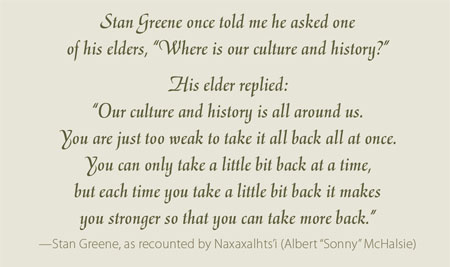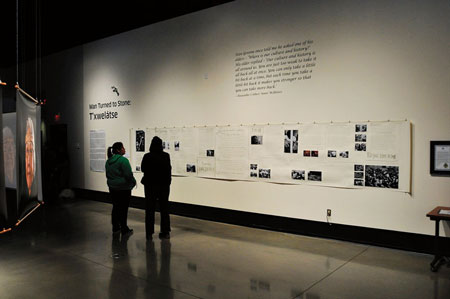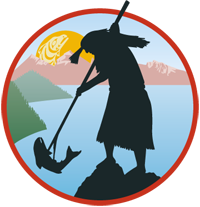![]()
![]()
Stó:lō Nation / Stó:lō Research
& Resource Management Centre

The Reach Gallery
Museum Abbotsford


The Loss and Return of Stone T'xwelátse
In the mid-1800s, Stone T'xwelátse was moved across Sumas Lake from the Chilliwack Valley when a Ts'elxwéyeqw woman married into the neighbouring Semá:th (Sumas) Tribe. The marriage was arranged to resolve a dispute between the tribes. In the late 1880s and early 1890s, Semá:th villagers retreated from the Sumas Prairie near the international border after vigilante groups from the United States attacked members of their villages. In 1892, T'xwelátse was "found" by local farmers living near the village who sold him to a "dime-store museum" in Sumas, Washington. Later, the Young Naturalists' Society, founders of Washington State's Burke Museum of Natural and Cultural History, purchased Stone T'xwelátse. In the early 1900s, he was moved to Seattle, where, for the next century, he was housed and occasionally displayed at the Burke Museum.
"His story was passed down through time—even after the man was lost," said Herb Joe, a carrier of the name T'xwelátse from the Tzeachten First Nation in Chilliwack. After fifteen year of efforts, Joe and the T'xwelátse family, with help from the Stó:lō Nation, the Nooksack Indian Tribe, and many others, successfully repatriated their ancestor from the museum. In October 2006, after 114 years of separation from his extended family, Stone T'xwelátse was repatriated and journeyed home again.

Storyboard for a Repatriation
In the spring of 2006, Herb Joe, one of the living T'xwelátses, invited writer Sandra Shields and photographer David Campion to follow the T'xwelátse family through the final months of the repatriation of Stone T'xwelátse and the subsequent homecoming celebrations.
Storyboard for a Repatriation reconstructs the epic journey of Stone T'xwelátse on a twenty-one-foot scroll that was hung in the gallery. The scroll was part of an installation that included a desk on which sat documentation from the repatriation process, including David Schaepe's repatriation reports and a computer playing the film T'xwelátse Is Finally Home, contributed by the Stó:lō Research and Resource Management Centre.
Storyboard for a Repatriation
Sandra Shields with David Campion, 2011, graphite on paper, ink-jet prints, 252 x 42 inches. Colour photographs courtesy of Patricia Charlie.
PLEASE CLICK ON THE IMAGE BELOW TO SEE A READABLE VERSION

